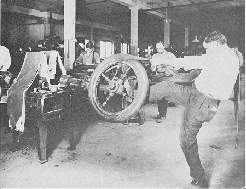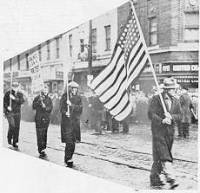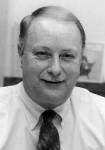|
The United Rubber Workers bring rich 60-year history to the USWA.
Akron, Ohio -- The newest members of the Steelworkers Union come from the 60-year-old United Rubber, Cork, Linoleum & Plastic Workers of America, founded September 12, 1935, in Akron -- then the "Rubber Capital of the World" and former home base for most of the major tire and rubber companies.
The union's founding was preceded by 30 years of struggle to organize. The "sit-down" strike was born among rubber workers as Rex Murray, later a charter member of the URW and then president of the General Tire local in Akron, led the first "sit-down" in June 1934.
Among the struggles of those days was the 1936 Goodyear strike, which saw 11 miles of picket lines around Akron. CIO President John L. Lewis of the Mine Workers rallied support for the rubber workers.

Violence against activists was common. URW founding President Sherman Dalrymple was beaten by company goons in Alabama.
But the numbers were increasing from the initial 3,050 founding members, and by the end of 1935 the URW had chartered 39 local unions. The first local in Canada was chartered in 1936 -- Local 67 in Kitchener, Ont.
Despite the Depression, morale and loyalty ran high, and by the late 1930s membership grew to more than 100,000. It continued to grow during World War II to nearly 190,000 in 222 locals by 1945 and to nearly 209,000 by June 1947.

In its 10th year --1945, the URW expanded its jurisdiction to cork, linoleum and plastics workers. In that year also, L.S. Buckmaster was elected president to lead the union during the national conversion to peacetime industry.
Traditionally, bargaining in the rubber industry had been on an individual plant basis. Working toward company wide bargaining, the union succeeded in 1946 in negotiating a general wage increase with the "Big Four" Goodyear, U.S. Rubber, Firestone and Goodrich -- in one set of negotiations. The first company wide agreement came in 1947, when a "master agreement" with U.S. Rubber was applied uniformly to 19 company plants. By 1948, all the major companies had "master agreements."
In 1949, the union established its first Fair Practices Department aimed at stamping out injustices based on race, sex, colour, religion or national origin. Also in 1949, the URW began to demand better pensions, and when Goodrich agreed to improve its contributory plan, the stage was set for achievement of union-negotiate non-contributory pensions and insurance plans in the Big Four.
In 1960, George Burdon, the union's organizing director, was elected international president. Peter Bommarito, president of Local 101 in Detroit, was elected vice president, and Ike Gold, of Firestone Local 7, was elected secretary-treasurer.
Bommarito was elected president in 1966 and served until 1981, becoming a legend in the union as a fighting leader. The year after his election, the URW confronted what Bommarito called an "unholy alliance" -- a mutual assistance pact among what had become the "Big Five" with the rise of Uniroyal. Bommarito led 52,000 men and women onto picket lines at the Big Five and 23 independent companies, as the union won major wage increases and benefit improvements.
Another of Bommarito's achievements was the establishment of a Joint Occupational Health Agreement as the URW became the first union to employ a full-time industrial hygienist, Louis S. Beliczky, in 1971.
In 1974, URW Canadian locals won cost-of-living adjustments after a lengthy strike, paving the way for U.S. locals to win similar inflation protection in 1976, with an 140-day strike at Firestone, Uniroyal, Goodrich and Goodyear.
In 1981, Milan "Mike" Stone became the URW's fifth president and led the union through the anti-labour 1980s. Against threats of losing COLA, the URW held its own. And in 1984, the union led the way toward health care cost containment reaching an agreement with Uniroyal months before 1985 contract talks were scheduled. Similar cost containment language with protection of benefits was then negotiated with Goodrich, Goodyear and Firestone.
Kenneth L. Coss was elected president in 1990 and led successful negotiations in 1991 with Bridgestone/Firestone, setting a pattern for the other companies. Building on an effort begun by Stone, the union won recognition at Bridgestone's new plant in Warren County, Tenn., based on a card check. This uncontentious recognition of URW Local 1155 certainly did not foretell the "War of '94" that Bridgestone was soon to launch against the URW and American workers.
Under Coss' direction, the URW made significant efforts to improve education programs and communications activities, and to strengthen labour-management cooperation. Recognizing the overwhelming challenges facing the URW and other industrial unions, Coss along with his union leadership, led the union toward the merger with the United Steelworkers. With that merger, the URW and the entire labor movement in North America have a new beginning. Today, the USWA Rubber/Plastic Industry Conference is led by John Sellers, appointed March 1, 1996 as the Executive Vice President of the Conference.

JOHN SELLARS EXECUTIVE VICE PRESIDENT
Headquarters - Akron, Ohio
John Sellers is serving his second term as executive vice president of the USWA Rubber/Plastics Industry Conference (R/PIC), representing former members of the United Rubber Workers. Sellers was appointed to that post on March 1, 1996, elected by delegates to an R/PIC conference in September 1996 and re-elected to a four-year term in September 1997.
Sellers joined URW Local 639 at AMF Voit in Santa Ana, Cal., in 1966 and was appointed to the URW staff in 1978. He joined the international staff in 1991 and served as organizing director, education director and political education director, as well as participating in master contract bargaining. With the USWA, Sellers coordinated the successful corporate campaign against Bridgestone/Firestone and leads the union's negotiations with the major tire companies. He also serves on the USWA International Executive Board.
|